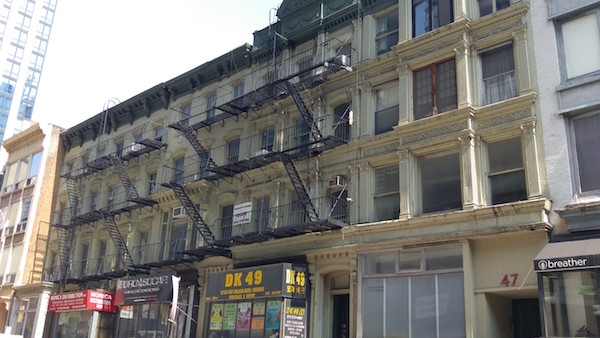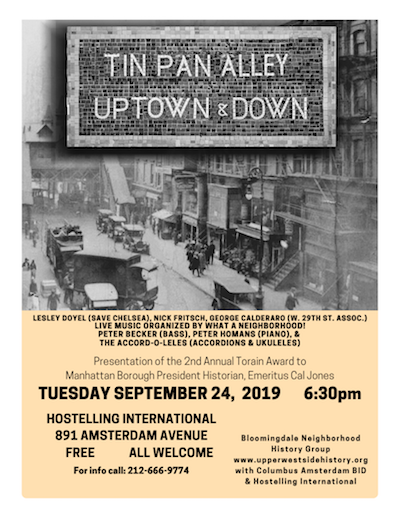
BY SCOTT STIFFLER | Tin Pan Alley is globally recognized as the birthplace of American popular music—and for decades, preservationists have sought its protection. Two upcoming events offer the public a chance to dive deep into Tin Pan Alley’s history, and become involved in the effort to see this site of significance remain intact.
Part 1 of Tin Pan Alley Uptown and Downtown happens Tues, Sept. 24, when tribute is paid to the great songwriters of Tin Pan Alley who lived in the Bloomingdale neighborhood of the Upper West side.
Local historian Jim Mackin’s PowerPoint presentation about notable composers and lyricists who called Bloomingdale home will serve as the framework for a half-dozen musical performances. Past Manhattan Borough Historian Mike Miscione will present the 2nd Annual Jim Torain Award to Manhattan Borough Historian Emeritus Cal Jones, and members of Save Chelsea will give their own PowerPoint presentation, offering a general overview of Tin Pan Alley. Manhattan Borough President Gale Brewer is expected to make a few remarks.
The 6:30pm Sept. 24 event takes place at Hostelling International (891 Amsterdam Ave. at 103rd St.). For info, click here. At the end of the event, attendees will have an opportunity to sign up for Save Chelsea’s Oct. 26 tour Tin Pan Alley, the Old Chelsea Theater District, and surrounding environs (including the important African American contribution).
Chelsea Community News recently asked Save Chelsea president Laurence Frommer to weigh in on what to expect at these two events. But first, a bit of background on current preservation efforts.
 George Calderaro is a board member of the 29th Street Neighborhood Association, and project head of Save Tin Pan Alley. In Dec. 2017, those groups met with the leadership of the Landmarks Preservation Commission (LPC) to, Calderaro recalled, “make our appeal with historians and preservationists, including Andrew Dolkart, author and professor of historic preservation at Columbia University; John Reddick, whose research focuses on Black and Jewish Musicians from the 1890s to the 1930s; and David Freeland, whose book, Automats, Taxi Dances, and Vaudeville: Excavating Manhattan’s Lost Places of Leisure, focused in part on Tin Pan Alley and the Tenderloin. We were apparently successful in making our case—a year later, we met with the Commission again, and were elated to hear that they were moving ahead with research for potential designation of five Tin Pan Alley buildings, 47-55 West 28th Street.”
George Calderaro is a board member of the 29th Street Neighborhood Association, and project head of Save Tin Pan Alley. In Dec. 2017, those groups met with the leadership of the Landmarks Preservation Commission (LPC) to, Calderaro recalled, “make our appeal with historians and preservationists, including Andrew Dolkart, author and professor of historic preservation at Columbia University; John Reddick, whose research focuses on Black and Jewish Musicians from the 1890s to the 1930s; and David Freeland, whose book, Automats, Taxi Dances, and Vaudeville: Excavating Manhattan’s Lost Places of Leisure, focused in part on Tin Pan Alley and the Tenderloin. We were apparently successful in making our case—a year later, we met with the Commission again, and were elated to hear that they were moving ahead with research for potential designation of five Tin Pan Alley buildings, 47-55 West 28th Street.”
On April 30, 2019, Calderaro noted, an LPC designation hearing for these five buildings was held, “and 30 groups and individuals testified passionately in favor of designation. Unsurprisingly, the owner of the buildings opposed the designations. Since April, we have continued to generate interest and support from around the country, to help make the case for protection of Tin Pan Alley. We are cautiously optimistic that landmark designation is imminent.”
Save Tin Pan Alley and its allies are also looking beyond designation, with an eye toward creating a music district on W. 28th St. “Ironically,” recalled Calderaro, “When I received word that a hearing was scheduled, I was in the process of writing to the Grammy Foundation about the potential for a Grammy Museum on Tin Pan Alley, where the American popular music industry was born!”
Below, see our Q&A with Frommer.
Chelsea Community News: Discuss how the Sept. 24 event is a collaborative effort between Bloomingdale Neighborhood History Group, Save Chelsea, the W. 29th St. Association, Save Tin Pan Alley.
Laurence Frommer: Many of the writers associated with Tin Pan Alley actually lived in the Upper West Side, the area between West 96th Street and West 110th Street that is still sometimes referred to as the “Bloomingdale Blocks.” The Bloomingdale Neighborhood History Group is putting together this wonderful event. They reached out to those of us in Save Chelsea and also the W. 29th St. Association and its sister group/initiative, Save Tin Pan Alley. Save Tin Pin Alley spearheaded the latest attempt to save some very important buildings on Tin Pan Alley, and we are hoping that the LPC will, in fact, approve the landmarking of four very important buildings on that block soon after what was likely a promising hearing back in the spring of this year. I will never say I am 100% certain of anything, especially when it comes to historic preservation or urban planning—so we certainly encourage people to continue to write to the LPC and encourage them to go through with landmarking these important, historic buildings. I might add that there was an opportunity several years ago to add the entire block in question to the Madison Square North Historic District and, sadly, the city didn’t do this. Personally, I think it would still be worth looking at this possibility. In fact, the two blocks of 28th Street, from Fifth Avenue to Broadway and then from Broadway to Sixth Avenue, are arguably worthy of being within an historic district.

CCN: Along with David Holowka, you’re leading an Oct. 26 walking tour of Tin Pan Alley. What can participants expect?
FROMMER: This tour will address the history and architecture of Tin Pan Alley on West 28th Street, but also the larger environs. In the 1890s, northern Chelsea was a major center of African American life before many folks moved to Harlem. And several folks from that community were involved as songwriters of Tin Pan Alley, and in the theater and entertainment world. Scott Joplin wrote his great opera Treemonisha while living in a boarding house on West 29th Street, very near to Tin Pan Alley. The old Kostar and Bial’s “The Corner” saloon on Sixth Avenue and West 24th Street is one of the very last remnants of the old Chelsea theater district. Their great music hall was on the same block, but is long gone. All the great theaters that once stood in the area are gone, but this one. Sadly, the Landmarks Commission has repeatedly refused to have a hearing regarding this very important historic structure.
CCN: Discuss your longtime involvement with Save Chelsea. Why should people get involved?
FROMMER: I hope Chelsea residents and New Yorkers will take an interest in what’s going on in Chelsea, because disturbing precedents are likely being set in our neighborhood. They can contact us through our website [www.savechelseany.org]. They can also reach out to groups like the Historic Districts Council, which helps efforts like ours, throughout the city. I have been the president of Save Chelsea for about three years, and was a general member before that for a few years. I originally got involved with Save Chelsea because of my interest in endangered important sites north of 23rd Street—and Tin Pin Alley and its environs were definitely on my list of concerns. With more buildings facing the wrecking ball, preservationists have attempted more than once to interest the city’s Landmarks Commission in a substantial expansion of the Madison Square North Historic District, but have, so far, failed.
We have had many losses of architecturally and historically significant structures in northern Chelsea: The Coogan building, an important example of proto- skyscraper technology, was de-landmarked in a political payoff, and then later demolished after a very disheartening fight in which the LPC refused to revisit the matter. The Bancroft Building, a beautiful 19th century red and white striped limestone office building on West 29th Street, is now gone. The Queen Ann-style Pequod Club On West 25th Street near Eighth Ave. was demolished to make way for a new upscale apartment building. The splendid Art Deco lobby of the Lefcourt Clothing Center on Seventh Ave. was largely destroyed, it’ gorgeous ceilings replaced with uninteresting tile. The Hopper Gibbons House, the only verifiable Underground Railroad safe house in Manhattan, has been at the heart of a decade-long battle, because the owner continued to flout the law via an illegal addition. Finally, after a decade, the illegal rooftop addition is gone—but the facade has yet to be restored.
But things are not so good south of Wets 23rd Street either. And right in the heart of the Chelsea Historic District, the oldest house in Chelsea was at the center of a very disturbing battle at the LPC, in which we feel the Commission acted improperly in various ways, and the result is that the owner won the right to tear down all but the facade of this important historic site and build a “McMansion” behind it. Having won that right, he has now put the property back on the market for about three million more than he bought it. Whoever buys it inherits the right to do this teardown. I might add that this past year, the then-Chair, left the LPC and went over to the firm of the owner’s legal representation, a woman who herself went through the revolving door from being legal council at LPC to representing the other side!
CCN: Please weigh in on any pertinent subject matter not covered in the above questions.
FROMMER: Historic Cushman Row on West 20th Street across, from the General Theological Seminary, continues to be a concern. Although the new owner of 418 West 20th Street was denied their application to do something similar as what was sadly granted at 404 West 20th (the oldest house in Chelsea), now the owner is returning to LPC with what we feel is merely a modification of the previous proposal. We hope that the Commission will very carefully read the blueprints and site plans to see if any teardown is being proposed. I say this because in the past, particularly as regards the tragedy of the oldest house in Chelsea, we’ve had a problem with commissioners seemingly ignoring what is right in front of their eyes and not challenging a presenter who is calling what is obviously a teardown an “addition” (at least if they know how to read blueprints and site plans, and if they don’t, they have no business being on the Commission).
Chelsea Community News is made possible with the help of our awesome advertisers, and the support of our readers. If you like what you see, please consider taking part in our GoFundMe campaign (click here). To make a direct donation, give feedback about the site, or send a Letter to The Editor, email us at Scott@chelseacommunitynews.com.

Pingback: Rent warehouse Pathum Thani
Pingback: รับจํานํารถ
Pingback: หัวพอตมาโบ
Pingback: อาหารเสริม omg
Pingback: ดูหนัง jav
Pingback: พิมพ์สติกเกอร์ฉลากสินค้าแบบม้วน
Pingback: pgroyalbet
Pingback: b52 club
Pingback: กงล้อ888
Pingback: ทัวร์หลีเป๊ะ
Pingback: รับทำเว็บ WordPress
Pingback: faw99 สล็อต
Pingback: superkaya88
Pingback: 웹툰 미리보기
Pingback: เว็บคาสิโนออนไลน์
Pingback: Hawaiian Psilocybe Mushrooms
Pingback: wikipedia reference
Pingback: DMT Vape Pens For Sale Brisbane
Pingback: เป็นหนองใน
Pingback: trouver plus ici
Pingback: online sex
Pingback: 토토백화점
Pingback: microdosing where to buy
Pingback: Dividend-paying stocks
Pingback: buy dmt
Pingback: buy fn american
Pingback: sbobet
Pingback: https://sboic.ca/the-secret-behind-how-to-influence-people/
Pingback: gotgals.com
Pingback: Firearms For sale online
Pingback: https://adpost4u.com
Pingback: madridiario.es
Pingback: Fortune Games® Real Money Casino Slot Games Slots
Pingback: conspiracy theory dating
Pingback: microsoft exchange hesabı kurulumu